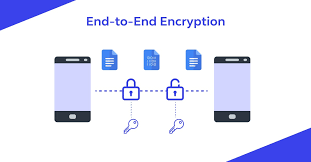A secure communication technique that is gaining popularity in today’s digital environment is end-to-end encryption, or E2EE. Nonetheless, it’s critical to comprehend end-to-end encryption and its operation given the escalating concerns regarding security and privacy.
How End-to-End Encryption Operates
Through the use of an encryption algorithm and encryption key, the encryption process transforms plaintext—a text that can be read—into ciphertext, or encrypted text. The communication is encrypted and decrypted using the encryption key, which is a special string of characters. The encryption keys for E2EE are created by the devices that are talking with each other and are not kept on any external server. This indicates that the only people who can read the contents of the communication are the sender and the recipient who have access to the encryption keys. The encryption method and encryption key are used by the sending device to encrypt a message before it is sent. After that, the encrypted communication is sent to the recipient’s device, where the decryption key is used to unlock it. The message is kept private and secure throughout transmission thanks to the encryption and decryption processes.
Advantages of using End-to- end Encryption.
Improved security, privacy protection, regulatory compliance, and user experience are just a few advantages of end-to-end encryption.
1.Enhanced Security: Even in the event that a communication is intercepted during transmission, E2EE guards against unwanted access and alteration.
2.Protection of Privacy: E2EE makes sure that a message’s contents are only available to the sender and recipient, which is crucial for preserving privacy.
3.Regulation Compliance: E2EE assists businesses in adhering to laws requiring secure communication techniques, like PCI-DSS for financial services and HIPAA for healthcare.
4.Better User Experience: E2EE can enhance user trust and overall user experience by removing the need for users to entrust third-party servers with their sensitive information.
End-to-end encryption’s drawbacks and restrictions
End-to-end encryption has a number of advantages, but it also has some drawbacks and restrictions.
1 Key management: E2EE necessitates the safe storage of encryption keys, which presents difficulties for certain businesses.
2.User Adoption: Because E2EE necessitates a fundamental understanding of encryption and key management, its adoption by non-technical users may be constrained.
3.Technical Difficulty: Implementing E2EE can be technically difficult and demand specific skills and resources.
End-to-end encryption and Blockchain
When talking about secure communication and data storage, end-to-end encryption and blockchain technology are two related topics that are frequently covered. Blockchain offers a safe, decentralised, and impenetrable means of storing and transferring data, while end-to-end encryption ensures the confidentiality and privacy of conversations.
End-to-end encryption and blockchain are complimentary technologies that work well together. While blockchain offers data storage decentralisation and security, end-to-end encryption protects communications privacy and security. Applications for this mix of technology include decentralised cloud storage, secure payment systems, and messaging networks.
One application of end-to-end encryption and blockchain technology is found in decentralised messaging services, where messages are encrypted and stored on a decentralised blockchain network. This offers a private and secure communication channel where the sender and recipient are the only ones who can view the message contents.
In conclusion, a key element of contemporary digital security is end-to-end encryption. By encrypting data before it leaves the sender’s device and only decrypting it on the recipient’s device, it safeguards confidential data as it moves between devices. Users can feel comfortable knowing that only the intended receiver can access their information thanks to end-to-end encryption. Anyone worried about the privacy of their digital information needs end-to-end encryption, whether for personal or professional use.

